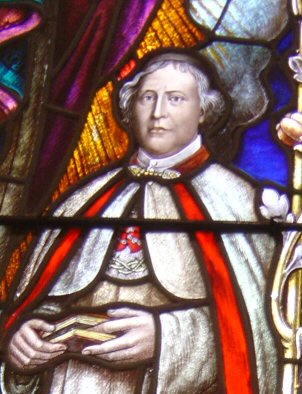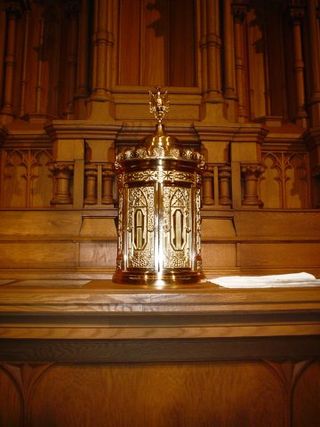Related Research Articles

The Congregation of the Sacred Hearts of Jesus and Mary abbreviated SS.CC., is a Catholic clerical religious congregation of Pontifical Right for priests and brothers. The congregation is also known as the Picpus because their first house was on the Rue de Picpus in Paris, France.

Genuflection or genuflexion is the act of bending a knee to the ground, as distinguished from kneeling which more strictly involves both knees. From early times, it has been a gesture of deep respect for a superior. Today, the gesture is common in the Christian religious practices of the Anglicanism, Lutheranism, the Catholic Church, and Western Rite Orthodoxy. The Latin word genuflectio, from which the English word is derived, originally meant kneeling with both knees rather than the rapid dropping to one knee and immediately rising that became customary in Western Europe in the Middle Ages. It is often referred to as "going down on one knee" or "bowing the knee". In Western culture, one genuflects on the left knee to a human dignitary, whether ecclesiastical or civil, while, in Christian churches and chapels, one genuflects on the right knee when the Sacrament is not exposed but in a tabernacle or veiled.
The Confraternity of Christian Doctrine (CCD) is an association established in Rome in 1562 for the purpose of providing religious education. In modern usage, it refers to the Confraternity of Christian Doctrine, Inc., which owns the copyright on the New American Bible Revised Edition, and is a term colloquially used for the catechesis or religious education program of the Catholic Church, normally designed for children. In some Catholic parishes, CCD is called PSR, meaning Parish School of Religion, or SRE, meaning Special Religious Education.

Eucharistic adoration is a Eucharistic devotional practice primarily in Western Catholicism, but also to a lesser extent in certain Lutheran and Anglican traditions, in which the Blessed Sacrament is adored by the faithful. This practice may occur either when the Eucharist is exposed, or when it is not publicly viewable because it is reserved in a place such as a church tabernacle.

A tabernacle or a sacrament house is a fixed, locked box in which the Eucharist is stored as part of the "reserved sacrament" rite. A container for the same purpose, which is set directly into a wall, is called an aumbry.
A canoness is a member of a religious community of women living a simple life. Many communities observe the monastic Rule of St. Augustine. The name corresponds to the male equivalent, a canon. The origin and Rule are common to both. As with the canons, there are two types: canonesses regular, who follow the Augustinian Rule, and secular canonesses, who follow no monastic Rule of Life.

During the Mass of the Faithful, the second part of the Mass, the elements of bread and wine are considered to have been changed into the veritable Body and Blood of Jesus Christ. The manner in which this occurs is referred to by the term transubstantiation, a theory of St. Thomas Aquinas, in the Roman Catholic Church. Members of the Orthodox, Anglican, and Lutheran communions also believe that Jesus Christ is really and truly present in the bread and wine, but they believe that the way in which this occurs must forever remain a sacred mystery. In many Christian churches some portion of the consecrated elements is set aside and reserved after the reception of Communion and referred to as the reserved sacrament. The reserved sacrament is usually stored in a tabernacle, a locked cabinet made of precious materials and usually located on, above, or near the high altar. In Western Christianity usually only the Host, from Latin: hostia, meaning "victim", is reserved, except where wine might be kept for the sick who cannot consume a host.

An ambry is a recessed cabinet in the wall of a Christian church for storing sacred vessels and vestments. They are sometimes near the piscina, but more often on the opposite side. The word also seems in medieval times to have been commonly used for any closed cupboard or even a bookcase.
In the Catholic Church, a canonical visitation is the act of an ecclesiastical superior who in the discharge of his office visits persons or places with a view to maintaining faith and discipline and of correcting abuses. A person delegated to carry out such a visitation is called a visitor. When, in exceptional circumstances, the Holy See delegates an apostolic visitor "to evaluate an ecclesiastical institute such as a seminary, diocese, or religious institute [...] to assist the institute in question to improve the way in which it carries out its function in the life of the Church," this is known as an apostolic visitation.
Congregation of the Heart of Mary is a name that applies to various Roman Catholic religious Congregations, most of them for women.
Forty Hours' Devotion, in Italian called Quarant'ore or written in one word Quarantore, is a Roman Catholic liturgical action in which continuous prayer is made for forty hours before the Blessed Sacrament in solemn exposition. It often occurs in a succession of churches, with one finishing prayers at the same time as the next takes it up.

The Mass of the Lord's Supper, also known as A Service of Worship for Maundy Thursday, is a Holy Week service celebrated on the evening of Maundy Thursday. It inaugurates the Easter Triduum, and commemorates the Last Supper of Jesus with his disciples, more explicitly than other celebrations of the Mass.
The Tabernacle Societies were lay Eucharistic Adorative associations within Roman Catholic parishes, principally in America and Australia, forming part of the Archassociation of the Eucharist under the guidance of the Association of Perpetual Adoration of the Blessed Sacrament.
Servants of the Most Blessed Sacrament is a Roman Catholic religious institute of women, founded by the Pierre-Julien Eymard in 1858, assisted by Marguerite Guillot, with the authorization of François-Nicholas-Madeleine Morlot, the Archbishop of Paris.
The Sisters of the Blessed Sacrament and Our Lady is an enclosed religious order and a reform of the Dominican Order devoted to the perpetual adoration of the Blessed Sacrament. The congregation was founded in Marseille in 1659 by a Dominican priest, Anthony Le Quieu.
The Priests' Eucharistic League was a Roman Catholic confraternity set up in the nineteenth century, with primary object the frequent and prolonged worship of the Blessed Sacrament by priests.
The Religious of the Perpetual Adoration was a religious congregation of the Catholic Church. It was founded by Sister Elizabeth Zwirer, in Einsiedeln, Switzerland, 1526, following the Benedictine rule.
The Sisters of the Precious Blood is a Roman Catholic female religious order founded in 1845 in Steinerberg, Switzerland by Magdalene Weber and a number of young women from Baden.
An altar society or altar guild is a group of laypersons in a parish church who maintain the ceremonial objects used in worship. Traditionally, membership was limited to women and their most common functions are making floral arrangements for the sanctuary, caring for linens, and holding fundraisers to purchase items for the sanctuary, including vestments and altar vessels.
The Sisters of Mary Reparatrix are a religious institute of women in the Catholic Church which was founded in France in 1857. Their way of life has been to combine adoration of God with the evangelization of society, especially for women.
References
- ↑ Van de Perre, Stijn. "Catholic Fundraising to Educate the Poor", The Civilising Offensive: Social and educational reform in 19th century Belgium, (Christoph de Spiegeleer, ed.), Walter de Gruyter GmbH & Co KG, 2018, p. 79 ISBN 9783110581546
- 1 2 Martin, C.L. "Religious of Perpetual Adoration." The Catholic Encyclopedia Vol. 11. New York: Robert Appleton Company, 1911. 13 June 2019
 This article incorporates text from this source, which is in the public domain .
This article incorporates text from this source, which is in the public domain . - 1 2 "Association of Perpetual Adoration", First National Catholic Congress, Leeds, July 29-August 2, 1910, Sands, 1910, p. 413
 This article incorporates text from this source, which is in the public domain .
This article incorporates text from this source, which is in the public domain . - 1 2 Rezek, Antoine. History of the Diocese of Sault Ste, Marie and Marquette, Marquette, Michigan, 1906, p. 305
 This article incorporates text from this source, which is in the public domain .
This article incorporates text from this source, which is in the public domain . - ↑ Lasance, Francis Xavier, "The Tabernacle Society", Blessed Sacrament Book, Benziger Brothers, 1913, p. 560
 This article incorporates text from this source, which is in the public domain .
This article incorporates text from this source, which is in the public domain .
![]() This article incorporates text from a publication now in the public domain : Herbermann, Charles, ed. (1913). "Religious of Perpetual Adoration". Catholic Encyclopedia . New York: Robert Appleton Company.
This article incorporates text from a publication now in the public domain : Herbermann, Charles, ed. (1913). "Religious of Perpetual Adoration". Catholic Encyclopedia . New York: Robert Appleton Company.